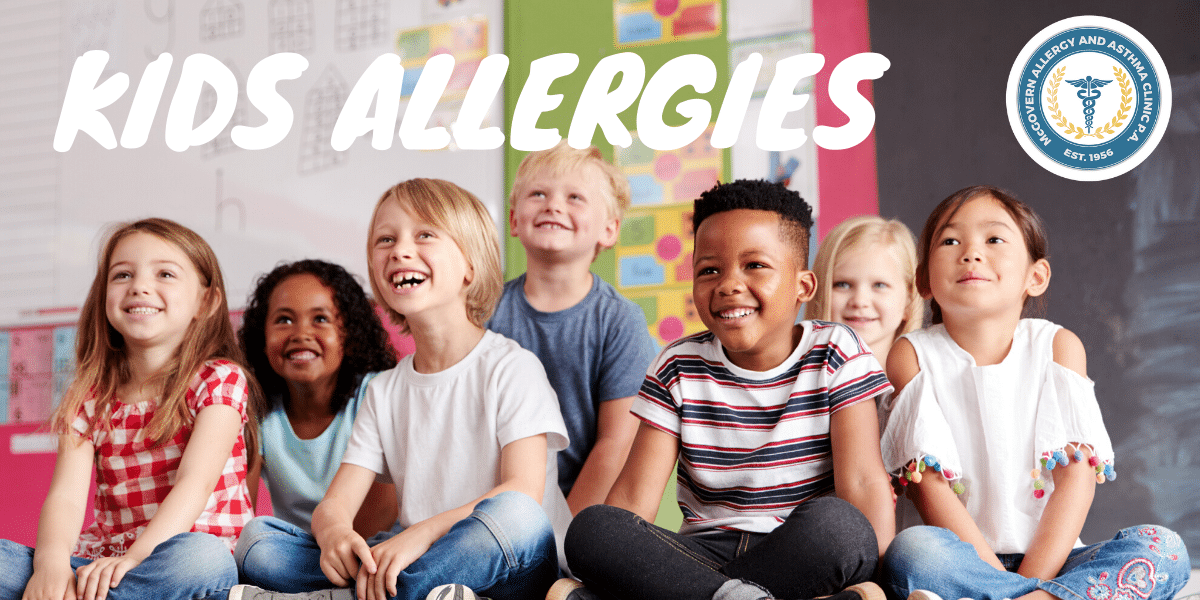Your child’s health can be unpredictable at times. Especially pertaining to kids with allergies. Children are susceptible to health risks even when they’re just playing outside. For example, you might not know if your child has allergies to outdoor elements, so a simple day at the park can trigger some allergy symptoms or reactions. However, don’t fret, you can still keep your child safe and comfortable with some knowledge under your belt and a few informative tips.
Kids With Allergies Indicators
Aside from speaking with an allergist, here are five ways to tell if your child is showing signs of allergies.
1.) Allergy symptoms are sometimes easy to identify based on patterns and exposure. Some signs can mimic cold-like symptoms, but allergy symptoms tend to last longer.
Signs to look out for:
- Eyes: irritated, swollen/red, and watery
- Ear, Nose, Mouth, and Throat: blocked ears, itchy blocked nose, sneezing, swollen lips or tongue, itchy or sore throat
- Lungs: coughing, wheezing, chest tightness, shortness of breath, and difficulty breathing
- Skin: itchiness or rashes
- Stomach: nausea, vomiting, and diarrhea
2.) Keeping track of when your child shows symptoms/reactions can help indicate if they have seasonal allergies and can also pinpoint the cause.
3.) Allergies to Pollen are seasonal, so if your child is showing symptoms at the same time each year, this might be the outdoor allergy trigger.
4.) Allergy triggers can also occur indoors, especially during Winter.
5.) A child can also have allergies due to genetics.
Common Allergens
Knowing what your child is allergic to is the easiest way to prevent allergic reactions. Early identification will improve your child’s quality of life in the long run and will reduce any potential life-threatening hazards.
Common allergens that trigger children:
- Outdoors: pollen and insects
- Indoors: bacterial enzymes, animal fur/dander, dust mites, and mold
- Irritants: smoke, perfume, and car exhausts
- Foods: peanuts, dairy, and fish
Different allergens appear during the changing seasons, and if your child has seasonal allergies, it’s important to pay attention to the weather and pollen count.
Allergen changes during the seasons:
- The pollen count is high when days are hot and windy. Generally, in the Spring and Summertime, pollen is most potent.
- In late Summer and Fall, ragweed and pollen levels are at their highest, especially in the mornings. Certain molds are also common during these seasons.
Tips For Kids With Allergies
Allergy symptoms are manageable for adults, but it can sometimes be stressful for kids with allergies. While some allergies can change and go away over time, knowing how to combat them as soon as your child starts showing symptoms is key.
Here are some tips to aid your child:
1.) Limit your child’s time outside when the pollen count is high. It’s best to keep doors and windows closed to avoid contamination. Make sure to change their clothes and shower after their time outside to remove any outside pollen or mold.
2.) Keep a clean house. Dust mites and indoor molds thrive in areas where moisture is plentiful. Furnishings like mattresses and pillows trap dust and mold, as a result, washing your sheets weekly is recommended.
3.) Make sure that your home is smoke-free. Whether it’s cigarettes, candles, or incense- smoke is bad for the lungs and nose.
4.) Keep your pets groomed and possibly outdoors if your child has allergies to pet fur.
Allergy Shots and Medicine for Kids With Allergies
If you are unsure what your child is allergic to, we recommend getting them allergy tested to determine the diagnosis and treatment plan. If regular allergy medication is ineffective, speaking with a pediatrician or an allergist for immunotherapy (allergy shots) may also be suggested.
Contact Us
If you’re struggling with allergies, asthma, or eczema- don’t suffer in silence. Book an appointment with one of McGovern Allergy and Asthma Clinic’s esteemed allergists today. Call 713-661-1444 or visit mcgovernallergy.com.

